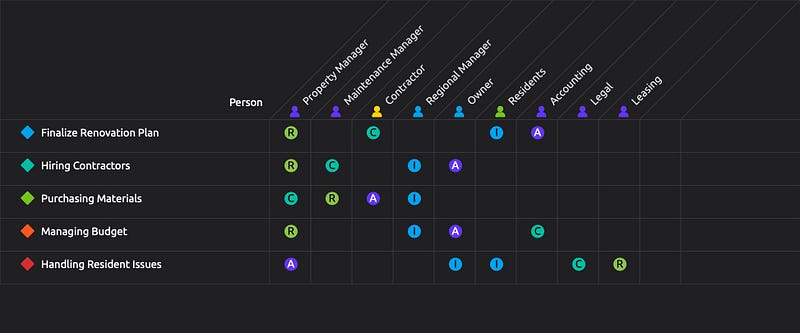Project Management Tips for Property Managers

Let’s be honest: managing properties is like trying to organize a group chat while dodging Wi-Fi drops — oh, and your phone’s at 1%. Between residents, contractors, and owners/executives, it’s easy to feel like you’re working retail on Black Friday, every day. But fear not! With a few project management tricks up your sleeve, you can keep the chaos in check and even look good while doing it. Let’s dive into some tips that will help you wrangle those projects like a seasoned pro.
1. Wrangling Your Stakeholders (Because They Won’t Wrangle Themselves)
Here’s the thing: everyone wants something. Residents want their running toilet fixed yesterday, owners want to cut costs but get more value (makes sense, right?), and contractors want to start… whenever they feel like it. The trick? Identify who the key players are before the chaos hits.
But don’t just make a mental note — let’s take it up a notch and create a RACI chart to sort out who’s responsible for what.
For those who aren’t familiar with this magic tool, RACI stands for Responsible, Accountable, Consulted, and Informed. It’s like a seating chart for your project, but instead of telling people where to sit, it tells them what to do so you can avoid those, “I thought you were doing that” moments of panic.
Example RACI Chart for a Property Renovation Project:

Practical Tip: When you make your RACI chart, you’ll immediately see who’s in charge, who’s on the hook, and who just needs an FYI so they don’t show up at the last minute asking why the can’t walk on the waxed floors. It’s a game-changer for keeping projects smooth — and your sanity intact.
2. Set Goals that Even Superman Could Achieve
Let’s cut to the chase: “improve resident satisfaction” isn’t a goal. It’s a dream, and we left those behind in the 2019. You need goals that are crystal clear, not pie-in-the-sky. Think specific, like “increase resident satisfaction by 10% this quarter by fixing maintenance requests faster than a speeding bullet (or, you know, within 24 hours).”
Practical Tip: Use the SMART framework (Specific, Measurable, Achievable, Realistic, and Time-bound). Think of it like setting goals that your boss — and maybe even a superhero — can actually get behind.
3. Timelines: Because “Soon” Isn’t a Deadline
Projects without timelines are just wishful thinking. Renovations, resident move-ins, even basic maintenance — without a clear timeline, you’re asking for trouble. “We’ll get it done eventually” just won’t fly (unless “eventually” is code for “never”… and it commonly is for some people).
Practical Tip: Break your project into phases. Need to renovate? Cool, break it down: inspections, bids, screaming matches with contractors, ordering materials, actual work (yes, it will happen). Assign real dates, and don’t forget to add buffer time for inevitable delays (because, you know… reality).
4. Communicate Like a Champ (or at Least Like You Care)
Good communication isn’t just about being “transparent” (everyone’s favorite corporate buzzword). It’s about making sure your stakeholders don’t go full “Where’s my money, Lebowski?” on you. Regular updates prevent surprises — and, let’s be honest, most people hate surprises unless there’s cake and balloons involved.
Practical Tip: Set up regular check-ins with owners, contractors, and anyone who might have a say in whether you keep your job. Even if everything’s on fire (not literally, we hope…), giving a heads-up can save you from last-minute panic and passive-aggressive emails.
5. Use Technology — Because Your Brain Can Only Handle So Much
Remember when people used to manage projects with pen and paper? Neither do I, because I blocked out those years at that company. With all the apps and tools available, there’s no reason to do it the hard way. Keeping track of deadlines, tasks, and who’s dropping the ball is way easier with a little tech help. There is a reason my former manager called me Boy Bot.
Practical Tip: Try free-to-start (and in some cases you may not even need to upgrade) tools like ClickUp or Trello to organize tasks and timelines. Even a basic Google Sheet can work wonders if you set it up right. Trust me, future you will thank you when you aren’t scrambling to remember whether you already paid that contractor (spoiler: you didn’t but they haven’t sent the invoice in).
6. Plan for the Worst (Because It’s Coming)
Let’s be real: something will go wrong. Murphy’s Law loves real estate. If something can go wrong, it probably will — just when you least expect it. Materials will be late, contractors will ghost you, and residents will suddenly have “emergencies” that require immediate attention (because it is imperative that the hinge that was apparently broken for 2 months be fixed today). Planning for these mishaps isn’t pessimism — it’s just common sense.
Practical Tip: Do a risk assessment before you start. What could go wrong? (Hint: if you’re me, everything.) Then, add buffer time, a contingency budget, and a strong cup of coffee. That way, when the inevitable happens, you’ll be ready to roll with the punches instead of being blindsided.
7. Monitor Progress (Or Watch It Spiral Out of Control)
It’s not enough to make a plan — you’ve got to check in to make sure things are still on track. Otherwise, your project might veer off course, and suddenly that “simple renovation” turns into a three-month nightmare that nobody signed up for.
Practical Tip: Regularly review your project milestones and timelines. Are things going according to plan, or are you veering into “what happened here?” territory? Be flexible enough to pivot when needed and communicate any necessary changes before people start asking questions (because they will).
Conclusion
Project management in property management is no small feat, but with the right approach, it’s doable — and dare I say, even fun? (Okay, maybe not fun, but at least less of a headache.) Managing stakeholders, setting clear goals, keeping timelines in check, and embracing technology will keep your projects on the rails — and help you avoid those “oh snap” moments that keep property managers up at night.
So grab your project manager hat (yes, it’s a metaphorical hat, but go ahead and get a real one if you want, I prefer a hard hat), follow these tips, and take control of your projects like the rockstar (ew did I really just say “rockstar”) property manager you are.
Be sure to subscribe here and on Medium if you are interested in receiving more tips and anecdotes!

Member discussion